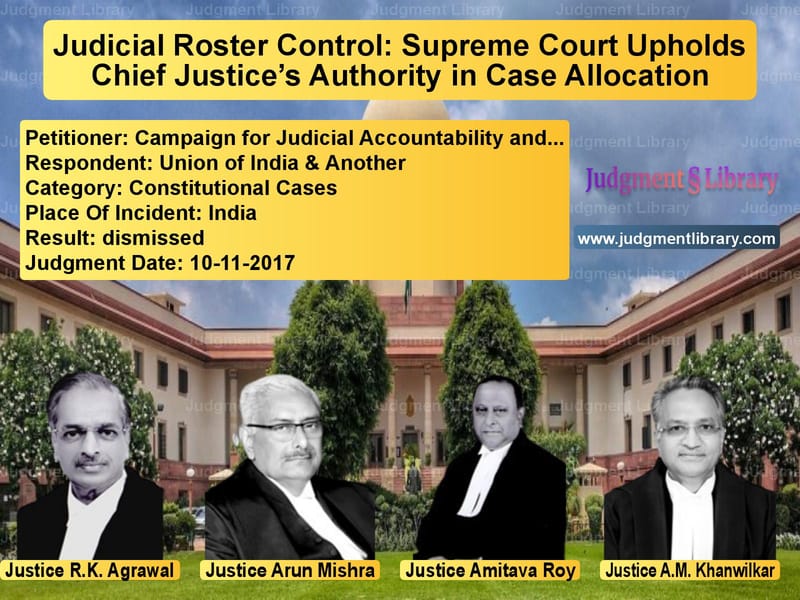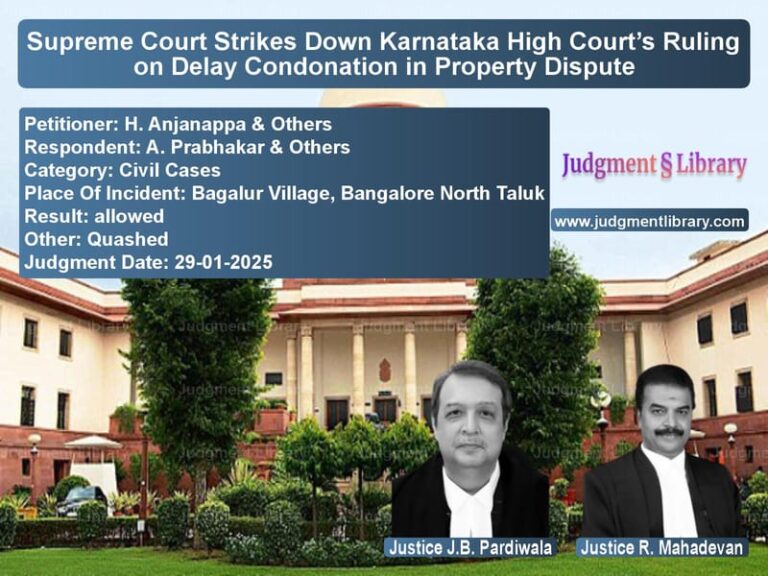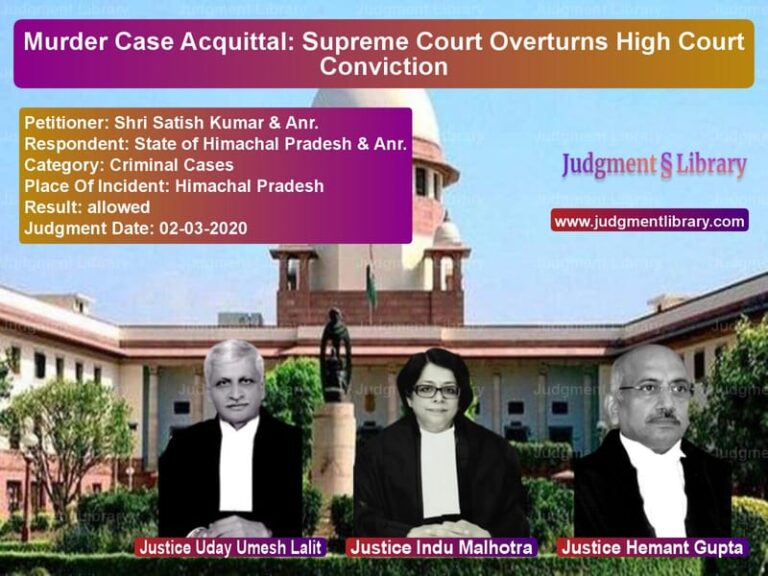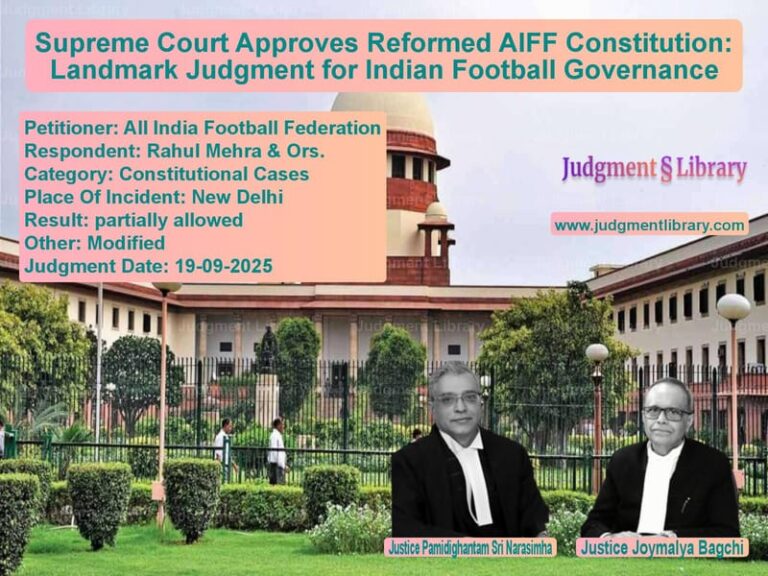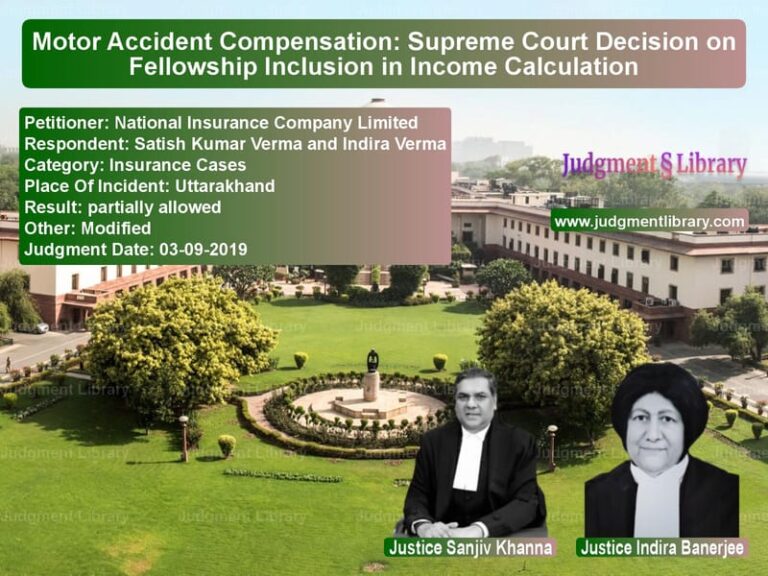Judicial Roster Control: Supreme Court Upholds Chief Justice’s Authority in Case Allocation
The Supreme Court of India recently ruled in the case of Campaign for Judicial Accountability and Reforms vs. Union of India & Another, which addressed a fundamental question about the powers of the Chief Justice of India in allocating cases to specific benches. This judgment reaffirmed that the Chief Justice of India is the master of the roster and has exclusive authority over the constitution of benches and assignment of cases.
Background of the Case
The case arose when the petitioner, Campaign for Judicial Accountability and Reforms, filed a writ petition challenging alleged irregularities in case allocation within the judiciary. The petition was initially listed before a two-judge bench comprising Justice A.K. Sikri and Justice Ashok Bhushan, who referred it to the Chief Justice of India for further action. The Chief Justice, exercising his administrative authority, constituted a five-judge Constitution Bench to examine the issue.
The key issue was whether any judge or bench could direct which bench should hear a matter or whether this power exclusively belonged to the Chief Justice of India.
Petitioner’s Arguments (Campaign for Judicial Accountability and Reforms)
The petitioner, represented by senior counsel, raised the following arguments:
- Judicial transparency requires a clear and structured system for assigning cases.
- Allegations of selective case allocation could compromise judicial independence.
- All cases dealing with similar constitutional questions should be assigned to a pre-designated bench rather than decided arbitrarily.
- The existing system lacked a structured process, leaving room for perceived bias in case assignments.
Respondent’s Arguments (Union of India & Others)
The Government of India, represented by the Additional Solicitor General and other senior advocates, argued:
- The Chief Justice of India has the constitutional authority to assign cases and determine the composition of benches.
- Any deviation from this principle could lead to administrative chaos within the judiciary.
- The Supreme Court’s established conventions and rules, including Order VI Rule 2 of the Supreme Court Rules, 2013, support this view.
- Similar principles have been upheld in the case of State of Rajasthan vs. Prakash Chand (1998), which held that the Chief Justice of a High Court is the master of the roster.
Supreme Court’s Judgment
The Supreme Court ruled in favor of the respondents, upholding the Chief Justice’s prerogative to allocate cases. The key observations included:
- “The administrative control of the High Court vests in the Chief Justice alone. The same principle must apply proprio vigore as regards the power of the Chief Justice of India.”
- “On the judicial side, the Chief Justice is first among equals, but as far as the roster is concerned, he alone has the prerogative to constitute benches.”
- “Neither a two-judge bench nor a three-judge bench can allocate matters to themselves or direct the composition of a bench.”
- “Any such order passed by any bench contrary to this principle shall be treated as ineffective in law.”
The Supreme Court further cited the constitutional provisions and judicial precedents that affirm the Chief Justice’s role:
- Article 145(2) and (3) of the Constitution of India provides that the rules made under this article may fix the minimum number of judges who are to sit for any purpose and determine how cases involving constitutional questions are heard.
- The State of Rajasthan vs. Prakash Chand (1998) ruling established that the Chief Justice of a High Court is the master of the roster, a principle equally applicable to the Supreme Court.
- The Official Liquidator vs. Dayanand & Others (2008) case reaffirmed that judicial discipline and propriety demand that smaller benches follow the decisions of larger benches.
Key Takeaways from the Judgment
- The Chief Justice of India has exclusive authority over the allocation of cases and formation of benches.
- No judge or bench can decide for itself which cases it will hear.
- The principle of the Chief Justice as the master of the roster is essential for judicial discipline.
- Any order that contradicts this principle is deemed ineffective.
- The judgment upholds judicial integrity and the administrative structure of the Supreme Court.
Conclusion
This ruling reinforces the Supreme Court’s commitment to maintaining order and discipline in case allocation. It ensures that bench composition remains impartial and free from manipulation. By upholding the Chief Justice’s prerogative, the judgment strengthens the institutional integrity of the judiciary and ensures that legal proceedings are conducted in a fair and consistent manner.
Don’t miss out on the full details! Download the complete judgment in PDF format below and gain valuable insights instantly!
Download Judgment: Campaign for Judicia vs Union of India & Ano Supreme Court of India Judgment Dated 10-11-2017.pdf
Direct Downlaod Judgment: Direct downlaod this Judgment
See all petitions in Constitution Interpretation
See all petitions in Separation of Powers
See all petitions in Public Interest Litigation
See all petitions in Judgment by Dipak Misra
See all petitions in Judgment by R K Agrawal
See all petitions in Judgment by Arun Mishra
See all petitions in Judgment by Amitava Roy
See all petitions in Judgment by A M Khanwilkar
See all petitions in dismissed
See all petitions in supreme court of India judgments November 2017
See all petitions in 2017 judgments
See all posts in Constitutional Cases Category
See all allowed petitions in Constitutional Cases Category
See all Dismissed petitions in Constitutional Cases Category
See all partially allowed petitions in Constitutional Cases Category

